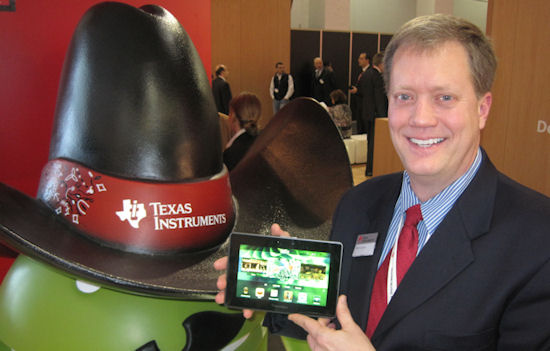Visual stimulus
We remain unconvinced about the overwhelming need for a mobile phone with an auto-stereoscopic 3D display, but there's no questioning it's eye-catching, ground-breaking and headline-grabbing. For this reason, if no other, Texas Instruments is pretty pleased with this first day on MWC 2011.
We attended the LG press event, at which the Android 3.0 Optimus Pad was also launched, but we've yet to spend any quality time with the Optimus 3D, and will save our account of LG at the show for when we can report our impressions of the display.
But Texas Instruments was as big a winner from the launch as LG itself, for two main reasons. First, perhaps in acknowledgement of the fact that few other devices have been launched sporting TI's long-awaited OMAP 4 series SoC, LG focused on the OMAP 4430 inside the Optimus 3D a lot more than is usually the case with handset launches.
And it was the relatively arcane field of memory and the channels connecting it to the CPU cores. The OMAP 4430 not only has two CPU cores, you see, it also has dual memory and dual channels connecting them. No doubt to the delight of LG's marketing people, these three lots of ‘dual' can be abbreviated to ‘3D'. Do you see what they did there?
The other big win for TI is that it will forever more be associated with the first 3D phone. Not only can the OMAP 4430 simultaneously record and play back 720p auto-stereoscopic 3D video, it can also play back 1080p 2D video.
We had a chat with Brian Carlson - OMAP line manager at TI, pictured below holding a BlackBerry Playbook - after the event, and ventured that it must be nice to see another product launch join the Playbook, especially with all the attention Tegra and Snapdragon are getting. Carlson concurred, but also insisted "There's a lot more in the pipeline."
While Qualcomm will often refer to its modem integration as a Snapdragon USP, and NVIDIA will, of course, big-up the graphics in Tegra, Carlson was keen to stress the visual processing credentials of OMAP. As well as the Optimus 3D, and clever things like its pico-projector technology, Carlson revealed TI is the first SoC maker to integrate things like face-recognition technology, and Kinect-like 3D gesture-driven UI support straight into the hardware.
Moving onto the recently- announced OMAP 5, Carlson was keen to emphasise it's about a lot more than just a horsepower increase. While clock-for-clock ARM Cortex A15 cores offer 50 percent higher performance than Cortex A9 ones, according to Carlson, there's no need to get carried away with the core count.
"It's all about the balance of performance and power, and we found dual-core to be the best implementation," said Carlson. The OMAP 5 series relies on Imagination Technologies' Power VR SGX544 MP graphics core for much of its visual prowess, but Carlson couldn't reveal how many graphics cores are used. It will begin sampling in the second half of this year with first products expected to begin appearing a year later.















